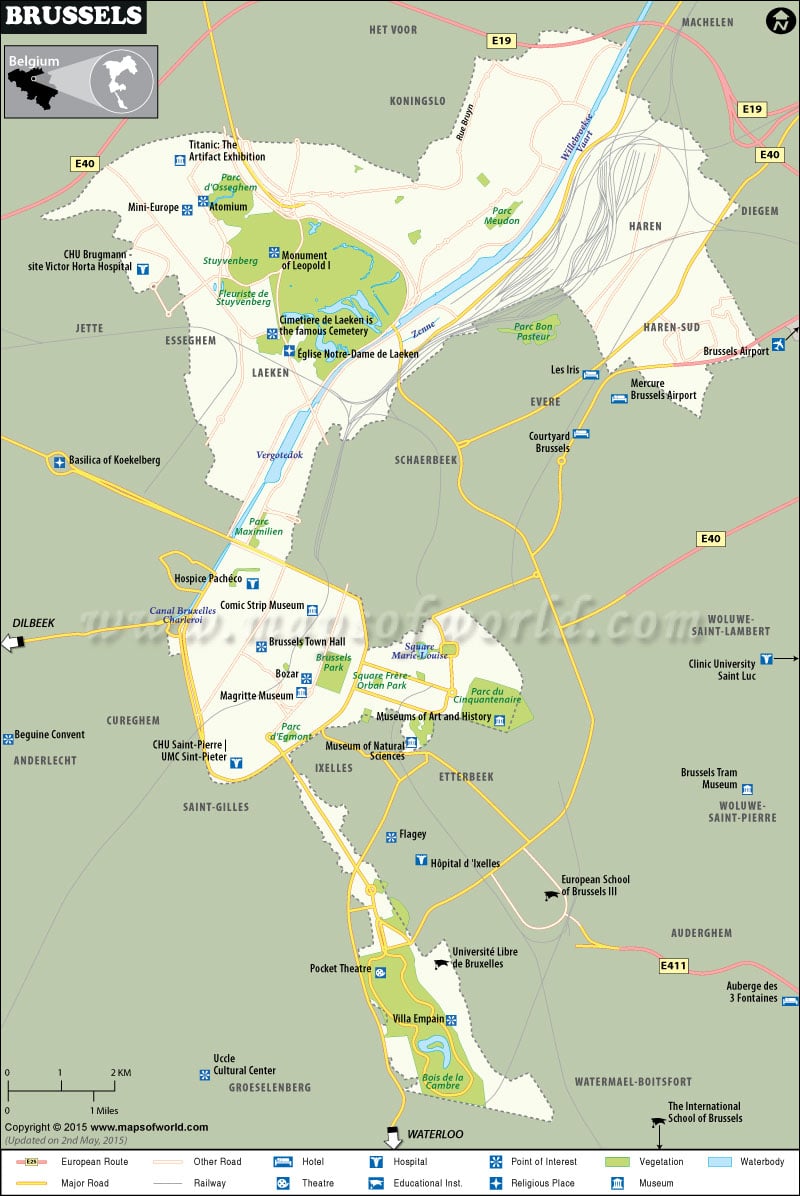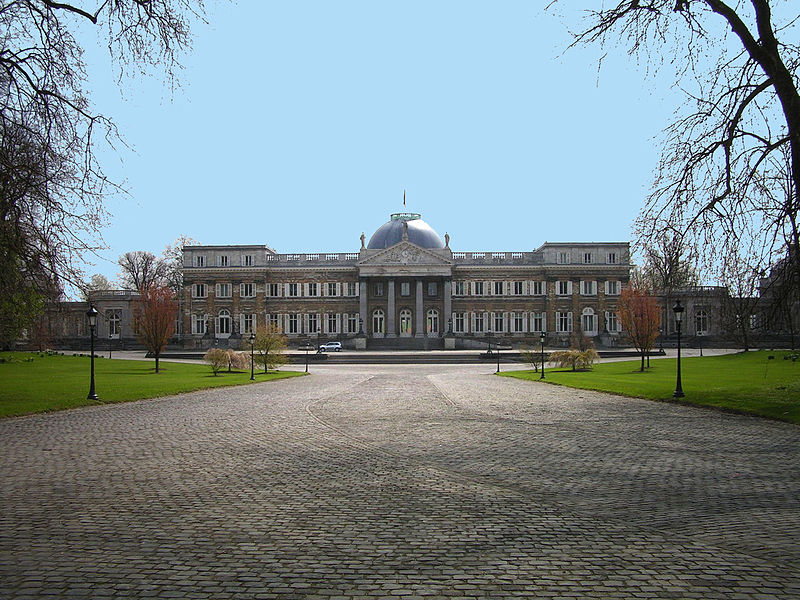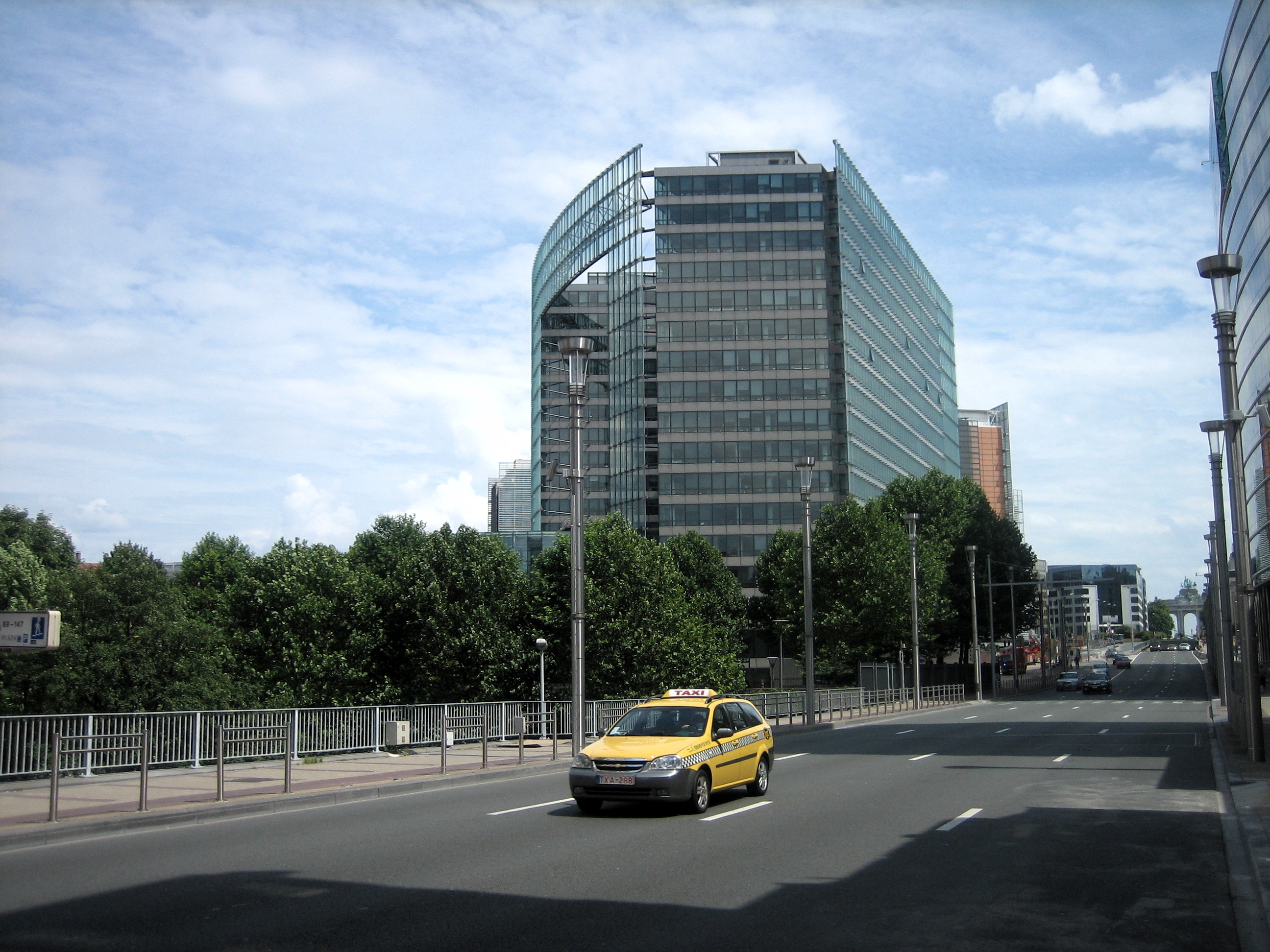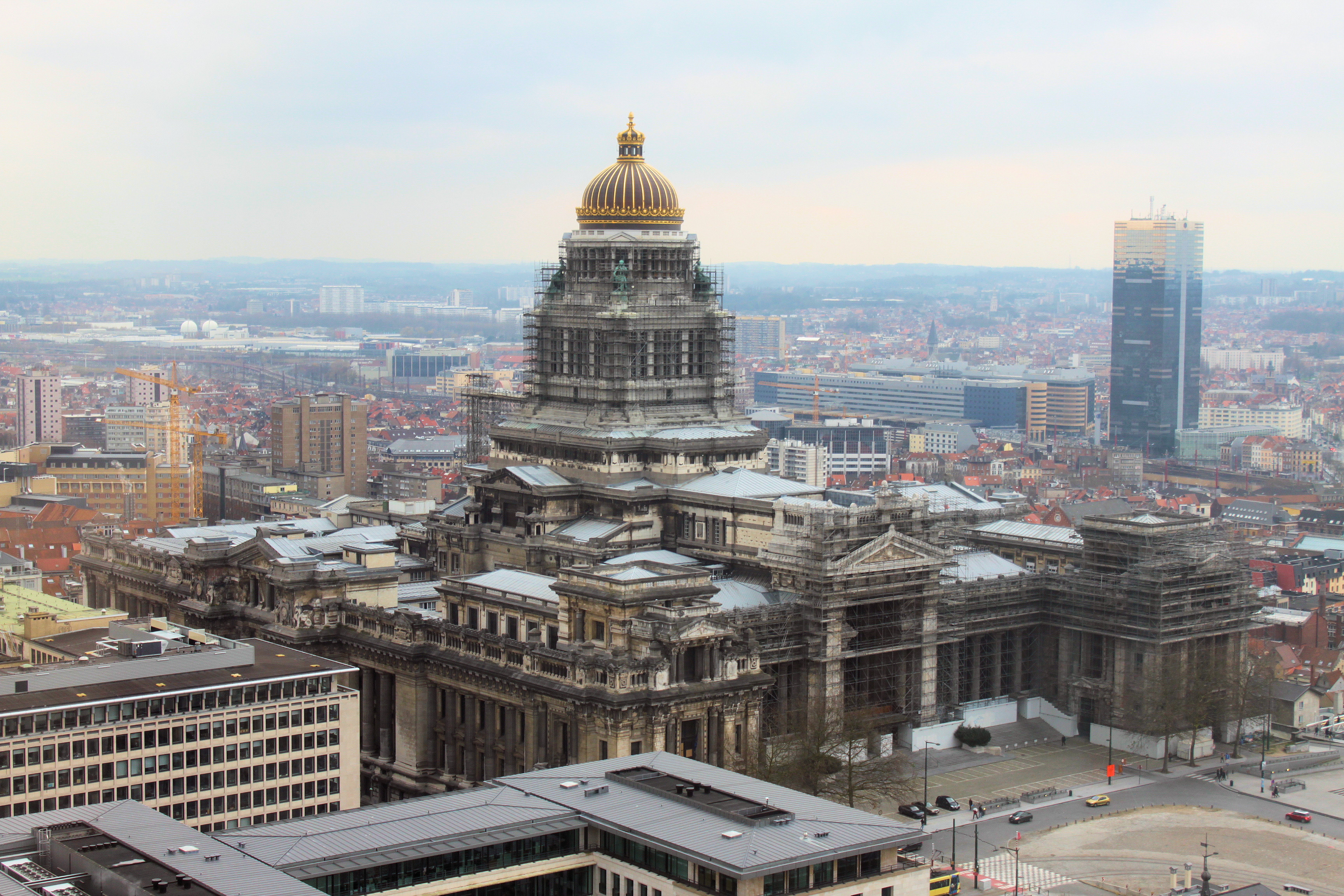 Dating back to the 11th century the city of Brussels has evolved countless times throughout history but some of the monuments, buildings and streets still exist today. Throughout the ages Brussels city has been the home of kings, the hub of activity for trade and enterprise from porcelain to tapestries and to this day you can still see the outline of the original city walls built into the modern cityscape...says its web site
Dating back to the 11th century the city of Brussels has evolved countless times throughout history but some of the monuments, buildings and streets still exist today. Throughout the ages Brussels city has been the home of kings, the hub of activity for trade and enterprise from porcelain to tapestries and to this day you can still see the outline of the original city walls built into the modern cityscape...says its web site  |
| Royal Palace |
Belgium became an independent state in 1830 after protests against the policies of King William of the Netherlands. Since then, Belgium has created its own Constitution and proclaimed its own sovereign – King Leopold of Saxe-Coburg was the first king of the Kingdom of Belgium
Brussels Pact
 |
| Royal Palace of Laeken |
Also known as the Brussels Treaty (17 March 1948) or the Treaty of Brussels, it is the historical initiation of a European cooperation that set the basis for the current European Union. The Brussels Pact was signed after the end of World War II by representatives of five countries: France, the Netherlands, Belgium, Luxembourg and the United Kingdom. It was an international contract to build Western European economic, social and cultural cooperation and collective self-defence.
 |
| European Paliament |
European Institutions
After being appointed the seat of the European Union, Brussels has become hub of European Union activity. The following institutions are now operating from Brussels: the European Commission, the European Parliament and NATO (the North Atlantic Treaty Organisation). In recent times the European Council has started to hold all quarterly summits in Brussels.
Local Government |
| Charlemagne Building |
Apart from the European institutions in Brussels, in view of democracy, Brussels has a regional government (Brussels Region) and 19 communes handling the activities of each area of the city. Each commune has its own mayor and cabinet.
Important Event:Flower carpet
 |
| Grand Palace |
Every two years the cobblestones of the Grand Place are covered in flowers. They are carefully positioned into a giant tableau symbolising a piece of Belgian culture. Hundreds of flower growers and horticulturists come together to put on this magnificent show in August. Visitors can see the grand carpet from up-high in the Town Hall for a small entrance fee.
PopulationBelgium covers an area of 30,528 square kilometers and has a population of about 10.5 million.
The public transport
 |
| Palace of Justice |
The public transport system is made up of the metro (underground trains), buses and trams that criss-cross the city. All of these services are operated by the same company STIB and therefore share the same ticketing system. This makes it easy to make transfers and to purchase tickets. Intercity trains are operated by a separate company SNCB but all the railway stations are connected to metro stations, tram stops and bus stops.
It is important to remember that Brussels is a bilingual city; all signage is written in French and Flemish.There are three main railway train stations in Brussels.All of them have trains that depart to other cities in Belgium and to other cities in Europe. Note that in Brussels everything is bilingual (French and Flemish) so you have to know both versions of the stations before you search for information, look at maps or book tickets online. Weather and Climate
Brussels’ climate is temperate and mild with winter lows of about 1°C and summer highs of around 23°C. There is rain all-year round so it pays to always have an umbrella or a waterproof jacket when touring around. The rains with the least amount of rain are April and May. On the sunny days, Brussels has a magnificent blue sky which is perfect for taking walks.
Politics
Belgium is a constitutional monarchy and a parliamentary democracy. The bicameral federal parliament is composed of a Senate and a Chamber of Representatives. Belgium is one of the few countries that has compulsory voting and thus holds one of the highest rates of voter turnout in the world.
Belgium is a constitutional monarchy and a parliamentary democracy. The bicameral federal parliament is composed of a Senate and a Chamber of Representatives. Belgium is one of the few countries that has compulsory voting and thus holds one of the highest rates of voter turnout in the world.

Economy
Beer, waffles and chocolate are usually the first trades that come to mind when talking about Belgium or Brussels. There are many other enterprises in Brussels which make up this economy as it handles its role as capital of Belgium and an international hub for foreign dignitaries, diplomats and expatriates.
Its location at the heart of a highly industrialized region helped make it the world's 15th largest trading nation in 2007. Belgium's main imports are raw materials, machinery and equipment, chemicals, raw diamonds, pharmaceuticals, foodstuffs, transportation equipment, oil products. Its main exports are machinery and equipment, chemicals, finished diamonds, metals and metal products, foodstuffs.
 |
| Belgium Architect |
 The Belgian economy is heavily service-oriented and shows a dual nature: a dynamic. One of the founding members of the European Union, Belgium strongly supports an open economy and the extension of the powers of EU institutions to integrate member economies. Since 1922, through the Belgium-Luxembourg Economic Union, Belgium and Luxembourg have been
The Belgian economy is heavily service-oriented and shows a dual nature: a dynamic. One of the founding members of the European Union, Belgium strongly supports an open economy and the extension of the powers of EU institutions to integrate member economies. Since 1922, through the Belgium-Luxembourg Economic Union, Belgium and Luxembourg have been a single trade market with customs and currency union
Steelmaking along the Meuse River at Ougrée, near Liège Belgium was the first continental European country to undergo the Industrial Revolution, in the early 19th century.
Noble Prize
ThreeNoble Prize in Physiology or Medicine were awarded to Belgians
ThreeNoble Prize in Physiology or Medicine were awarded to Belgians
Belgium has three official languages, which are in order of native speaker population in Belgium: Dutch, French and German.
Since the country's independence, Roman Catholicism, counterbalanced by strong freethought movements, has had an important role in Belgium's politics. However Belgium is largely a secular country as the laicist constitution provides for freedom of religion, and the government generally respects this right in practice.
 Symbolically and materially, the Roman Catholic Church remains in a favourable position. Belgium's concept of "recognised religionsset a path for Islam to follow to acquire the treatment of Jewish and Protestant religions. While other minority religions, such as Hinduism, do not yet have such status, Buddhism took the first steps toward legal recognition in 2007. According to the 2001 Survey and Study of Religion, about 47% of the population identify themselves as belonging to the Catholic Church, while Islam is the second-largest religion at 3.5%.
Symbolically and materially, the Roman Catholic Church remains in a favourable position. Belgium's concept of "recognised religionsset a path for Islam to follow to acquire the treatment of Jewish and Protestant religions. While other minority religions, such as Hinduism, do not yet have such status, Buddhism took the first steps toward legal recognition in 2007. According to the 2001 Survey and Study of Religion, about 47% of the population identify themselves as belonging to the Catholic Church, while Islam is the second-largest religion at 3.5%.
Health
 The life expectancy numbered 79.5 years.Health care is of high quality and is financed through both social security contributions and taxation. Health insurance is compulsory. However health care is delivered by a mostly private system of independent medical practitioners and hospitals. Most of the time each provided service is directly paid by the patient and reimbursed later on by health insurance companies. Belgian health care system is supervised and financed by the federal government.
The life expectancy numbered 79.5 years.Health care is of high quality and is financed through both social security contributions and taxation. Health insurance is compulsory. However health care is delivered by a mostly private system of independent medical practitioners and hospitals. Most of the time each provided service is directly paid by the patient and reimbursed later on by health insurance companies. Belgian health care system is supervised and financed by the federal government.
International rankings
Institute for Economics and Peace Global Peace Index 15 out of 144
United Nations Development Programme Human Development Index 17 out of 182
Transparency International Corruption Perceptions Index 21 out of 180 World Economic Forum Global Competitiveness Report 18 out of 133
 |
| Hanze(city Bruges) |
 |
| Congress column |
 La Grand-Place in Brussels is a remarkably homogeneous body of public and private buildings, dating mainly from the late 17th century. The architecture provides a vivid illustration of the level of social and cultural life of the period in this important political and commercial centre.It is located on former marshland on the right bank of the River Senne, to the east of the castellum, a defensive outwork of the castle built around 977 by Charles of France, Duke of Lower Lotharingia. The marsh was drained in the 12th century. The present rectangular outline of the Grand'Place has developed over the centuries as a result of successive enlargements and other modifications, and did not take up its definitive form until after 1695.
La Grand-Place in Brussels is a remarkably homogeneous body of public and private buildings, dating mainly from the late 17th century. The architecture provides a vivid illustration of the level of social and cultural life of the period in this important political and commercial centre.It is located on former marshland on the right bank of the River Senne, to the east of the castellum, a defensive outwork of the castle built around 977 by Charles of France, Duke of Lower Lotharingia. The marsh was drained in the 12th century. The present rectangular outline of the Grand'Place has developed over the centuries as a result of successive enlargements and other modifications, and did not take up its definitive form until after 1695. |
| Statue of Leopold I at the top of the column |
 |
| Veiw from room No 1708 of Sheraton hotel (Rogierplein) |
 |
| Wandering in street of Rogierplein |
 |
| Roman catholic church Koekelberg Basilica |
 |
| Martelaarstplein |
Apart from sightseeing, Brussels offers many other attractions. Sablon, the centre of art galleries and antiques shops, is one of the most attractive areas in this town.
 |
| Manneken-Pis |
 |
| Inside veiw of a train coatch |
Antwerp, on the River Scheldt, is the second largest city in Belgium, the second largest European harbour and a place with so many different faces. What’s more, it is a splendid city with endless architectural monuments, a large Medieval cathedral, and richly-decorated well-to-do houses. Antwerp also serves as the fashion capital where The Antwerp Six designers come from and houses Europe’s most important diamond trading centre.
Many tourists flock to another splendid Belgian city – Bruges. Both cosmopolitan and cosy, Bruges enchants with its ancient streets, historical houses, romantic canals and bridges, contributing to its somewhat fairy-tale like atmosphere.
Just Paris have the Eiffel Tower, Brussels have – Atomium. The World Expo of 1958 left behind a gigantic structure that shone in the spring sun in the shape of an atom. It is a replica of an iron crystal enlarged 165 billion times.
You must visit the Heysel area of Brussels to explore the Atomium which yields a spectacular view of the city as well as art and science exhibitions and a restaurant in its 9 spheres.The monument stands 102 meters tall.
It symbolised the democratic will to maintain peace among all the nations, faith in progress, both technical and scientific and, finally, an optimistic vision of the future of a modern, new, super-technological world for a better life for mankind.
Tubes are connected to the spheres along the 12 edges of the cube and all eight vertices to the center. They enclose escalators connecting the spheres containing exhibit halls and other public spaces. The top sphere provides a panoramic view of Brussels. Each sphere is 18 metres in diameter.
You must visit the Heysel area of Brussels to explore the Atomium which yields a spectacular view of the city as well as art and science exhibitions and a restaurant in its 9 spheres.The monument stands 102 meters tall.
It symbolised the democratic will to maintain peace among all the nations, faith in progress, both technical and scientific and, finally, an optimistic vision of the future of a modern, new, super-technological world for a better life for mankind.
 |
| Atomium |
The Atomium is located on Boulevard du Centenaire, beside the King Baudouin Stadium in Heysel Park. Just next to it lies the Mini-Europe park and the Heysel/Heizel metro station.
An interesting fact is that there are two other Brussels in world, one in Canada and one in the United States.











Thanks for this. I really like what you've posted here and wish you the best of luck with this blog and thanks for sharing.
ReplyDeleteCharleroi Airport Taxi